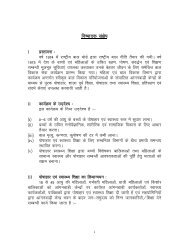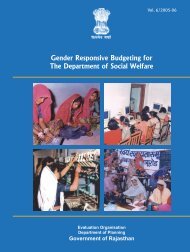Gender Responsive Budgeting for The Department of Registration ...
Gender Responsive Budgeting for The Department of Registration ...
Gender Responsive Budgeting for The Department of Registration ...
Create successful ePaper yourself
Turn your PDF publications into a flip-book with our unique Google optimized e-Paper software.
PREFACE<br />
<strong>The</strong>re is a broad consensus that ‘development if not engendered is endangered’, as first<br />
elucidated in the Human Development Report <strong>of</strong> 1995. Inspite <strong>of</strong> a lapse <strong>of</strong> over a decade,<br />
this still holds good. In the context <strong>of</strong> development, the critical thing to bring about is<br />
gender equality and women’s empowerment. <strong>The</strong> Government <strong>of</strong> Rajasthan is committed to<br />
seeing this happen. While there are a number <strong>of</strong> approaches and means that can be used<br />
<strong>for</strong> this purpose, here we are taking advantage <strong>of</strong> the tool <strong>of</strong> gender responsive budgeting<br />
to ensure this. <strong>Gender</strong> responsive budgeting is known to be an extremely efficient tool<br />
<strong>for</strong>, not only mainstreaming gender and promoting women’s empowerment, but also<br />
indispensable <strong>for</strong> translating good policies into concrete realities on the ground.<br />
This publication “<strong>Gender</strong> <strong>Responsive</strong> <strong>Budgeting</strong> <strong>for</strong> the <strong>Department</strong> <strong>of</strong> <strong>Registration</strong> and<br />
Stamps in Rajasthan” is the fifth in a series <strong>of</strong> gender responsive budgeting publications<br />
being brought out by the Government <strong>of</strong> Rajasthan. <strong>The</strong> credit <strong>for</strong> this <strong>for</strong>ward looking<br />
and analytical outlook on the part <strong>of</strong> the Government is due entirely to the vision and<br />
leadership <strong>of</strong> the honourable Chief Minister, Vasundhara Raje. Firmly driven by her, gender<br />
budgeting has come to stay, in Rajasthan. <strong>The</strong> biggest strength <strong>of</strong> the gender budgeting<br />
initiative here is the fact that it is State-led and very much a part <strong>of</strong> the Government’s<br />
agenda. <strong>The</strong> Directorate <strong>of</strong> Evaluation and the Directorate <strong>of</strong> Economics and Statistics <strong>of</strong><br />
the <strong>Department</strong> <strong>of</strong> Planning have played a very key role in this whole exercise.<br />
To start with, we have taken up the gender budget analysis <strong>of</strong> six departments – those<br />
<strong>of</strong> Health, Education, Agriculture, Women and Child, Stamps and <strong>Registration</strong> and Social<br />
Welfare. <strong>The</strong> process <strong>for</strong> doing this analysis was very participatory. Officers <strong>of</strong> the concerned<br />
departments worked closely with experts from UNIFEM, UNFPA and IFES to brainstorm and<br />
put together these reports. We now, however, need to move <strong>for</strong>ward from only analysing<br />
budgetary allocations and outputs <strong>for</strong> boys and men on the one hand and girls and women<br />
on the other, to looking at more concrete results, to looking at impacts and outcomes, to<br />
analysing benefit incidence ratios etc.








